

Discover the Temple of Literature, a precious gem of Hanoi, where Vietnamese intellect and culture converge, attracting millions of domestic and international visitors annually. Join BDATrip to explore this famous site through our detailed and fascinating article!
The Temple of Literature, a renowned historical architectural complex, was established in 1070 under the reign of Emperor Lý Thánh Tông. Built as a tribute to Confucius and his disciples, it served not only as Vietnam's first educational center but also as a training ground for scholars, officials, and royals. Famous for organizing national academic examinations, it selected and honored the most exceptional individuals on historic stone steles placed here.
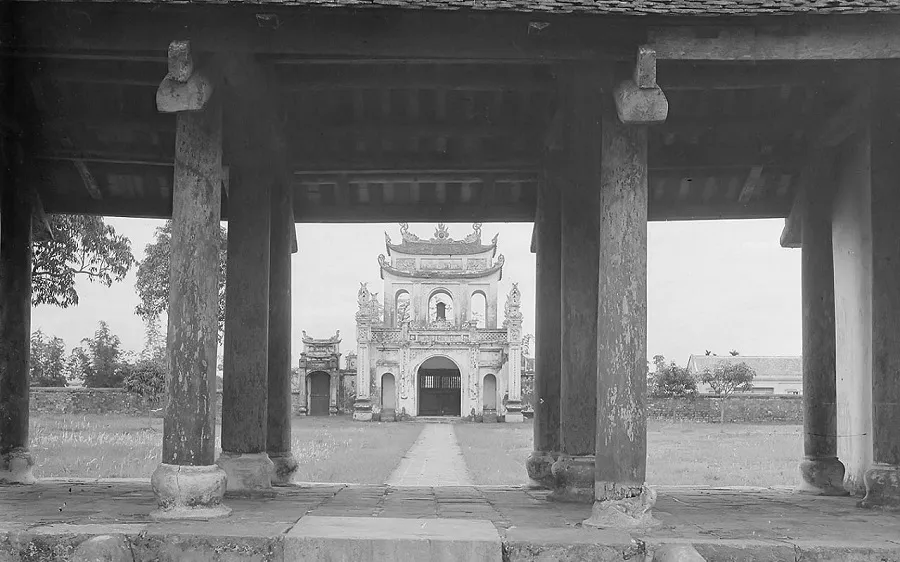
Through centuries, the Temple of Literature has witnessed various ups and downs. In 1253, Emperor Trần Thái Tông expanded it by adding the Imperial Academy (Quốc Tử Giám), teaching subjects like literature, mathematics, astronomy, and music. In 1484, Emperor Lê Thánh Tông established 82 doctoral steles, recording those who passed exams from the Lý to the Le dynasties. In 1802, Emperor Gia Long moved the Imperial Academy to Huế, turning the Temple into a place of scholarly worship. Despite severe damage during the 1947 war, it was restored and, in 2010, recognized by UNESCO as a World Cultural Heritage site, a testament to Vietnam's cultural and educational evolution through the ages.
Located at 58 Quốc Tử Giám Street, in the heart of Văn Miếu Ward, Đống Đa District, Hanoi, the Temple of Literature is easily accessible from every corner of the capital. Visitors can choose various transportation modes to get there, from buses, motorbikes, bicycles, to taxis. For a unique and intimate experience while exploring the Temple, a cyclo ride through the tranquil streets of Hanoi is also an excellent choice.
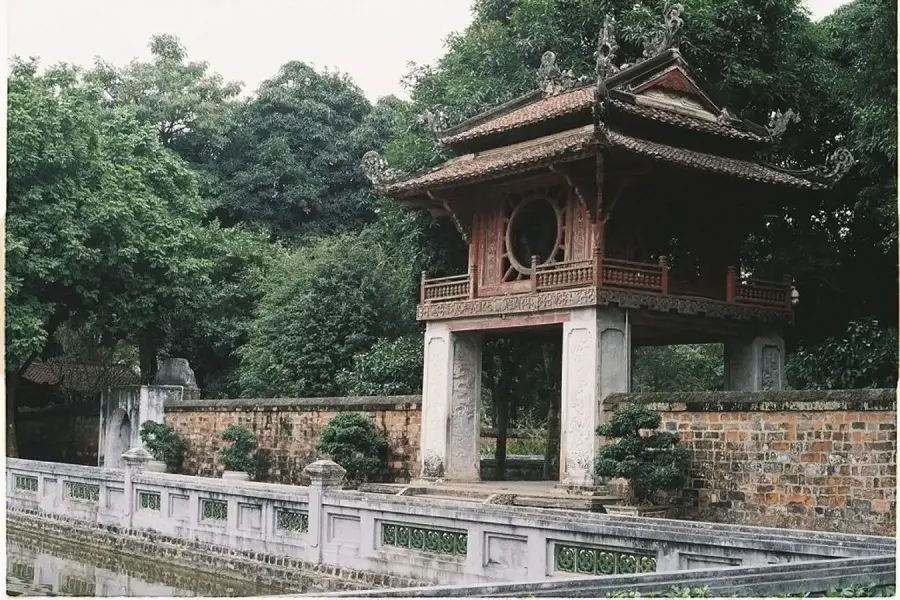
The Temple welcomes visitors from 8:00 AM to 5:00 PM daily, except during national holidays. The entrance fee is 30,000 VND per person. Tickets can be purchased at the main entrance ticket booth. For discounts for specific groups like the elderly and children, visitors should carry personal identification documents like ID cards or passports.
Spanning approximately 54,000 m2, the Temple is divided into five main areas, each corresponding to an entrance. It features buildings and spaces meticulously arranged, creating a solemn and peaceful atmosphere.
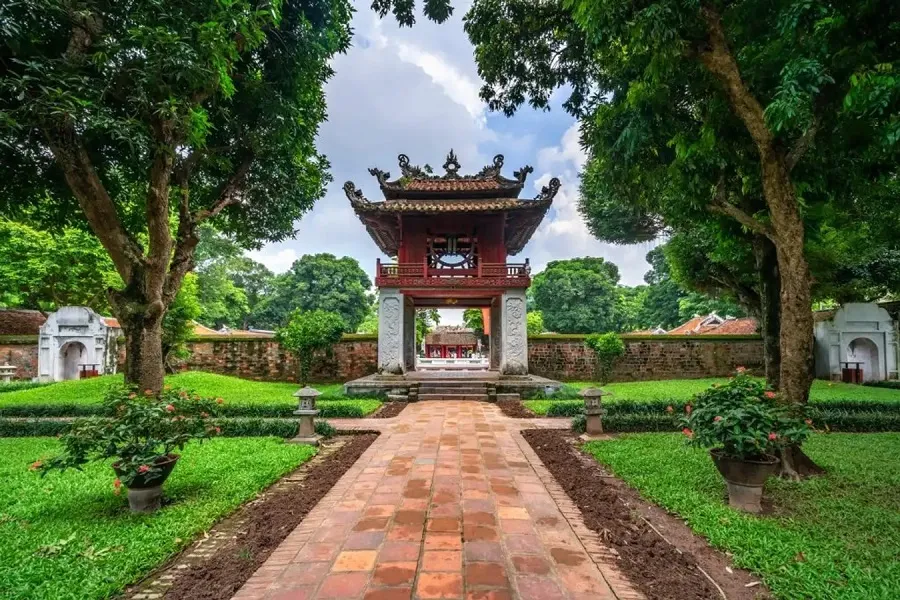
Van Mieu Mon, the grand main gate leading into the Temple, located in the east of the complex, is a traditional three-gate entrance, each with profound symbolic meanings, blending Vietnamese traditions and culture. The words "Van Mieu Mon" are carved in ancient Chinese script, highlighting the artistry and history.
Ho Giam, situated west of Van Mieu Mon, is a man-made rectangular pond, encircled by lush trees, creating a serene environment. Two small islands in the pond, Van Thanh and Tho Thanh, rich in cultural significance, host statues of Confucius and his outstanding disciples, Yen Huy and Tang Tu.
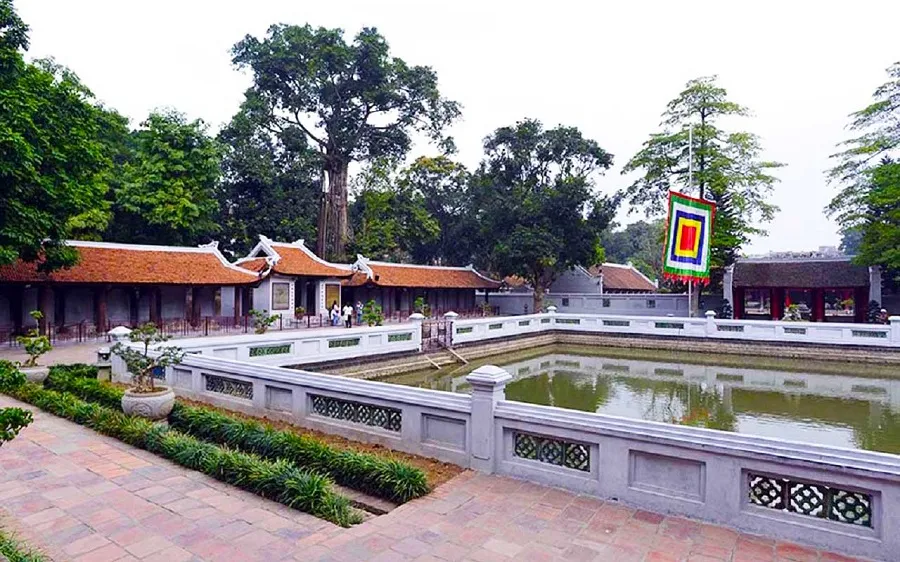
Dai Trung Mon, a sturdy, majestic gate north of Ho Giam, with three wide entrances, exemplifies the traditional Vietnamese triple-gate design. "Dai Trung Mon" is artistically inscribed in Chinese on its façade, symbolizing integration of ancient culture and modern architecture. This gate is not only an architectural icon but also leads to the area honoring Confucius and his disciples, reflecting the essence of culture and educational philosophy.
Khue Van Cac, a distinctive architectural masterpiece, stands north of Dai Trung Mon. Designed with four sturdy pillars, it resembles a two-story structure, harmoniously blending wood and stone. The red-tiled upper floor, adorned with intricate patterns, highlights traditional beauty, while the lower floor's wide windows offer panoramic views in all directions.

Gieng Thien Quang, an intriguing historical relic, located west of Khue Van Cac, features a unique square design, balancing nature and architecture. Surrounded by cooling greenery
, it adds tranquility to the site. "Thien Quang" means "Heaven's Light," symbolizing not only its literal meaning but also reflecting the profound philosophy of honoring wisdom and enlightenment in Vietnamese culture.
Flanking Khue Van Cac, the 82 Doctoral Steles stand as ancient stone records, chronicling Vietnam's illustrious educational history. They list the names of scholars who passed national exams from the Ly to the Le dynasties, from 1442 to 1779. Each stele is respectfully mounted on a stone turtle, a symbol of immortality and perpetuity. These steles not only testify to a longstanding scholarly tradition but also serve as valuable historical documents, reflecting the continuous cultural and societal development of Vietnam over centuries.
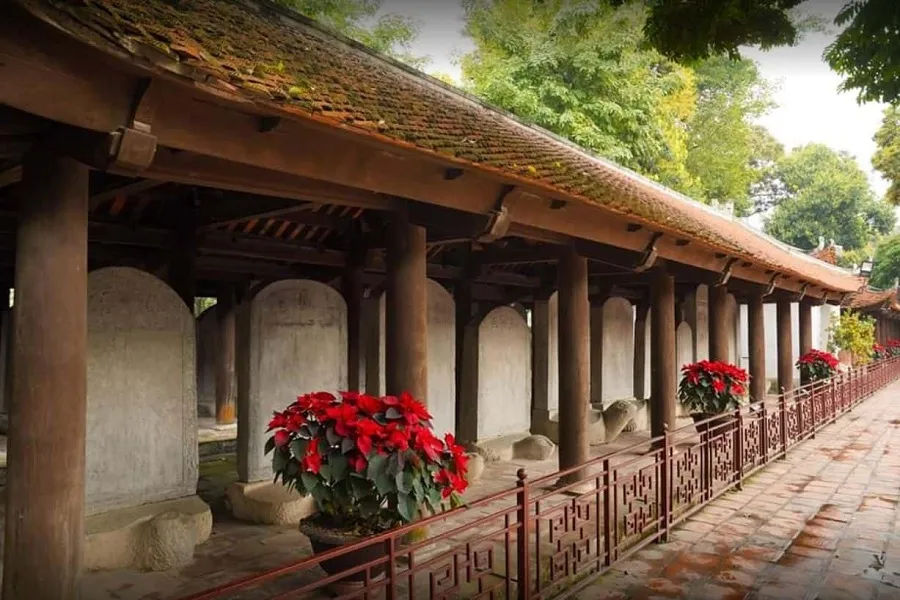
Dai Thanh Mon, the third gate exuding dignity in the Temple, stretches north of Khue Van Cac. This structure impresses with its three spacious entrances, each opening a chapter of Vietnam's history and culture, built in the traditional triple-gate style. The Chinese inscription "Dai Thanh Mon" on the gate honors the spirit and solemnity of the site. It leads to the area honoring Emperor Lý Thánh Tông and other kings who contributed to the Temple.
Dai Bai Duong, a magnificent and spacious building, site north of Dai Thanh Mon. Rectangular in design and harmonizing wood and stone, it epitomizes symmetry and solidity. Its red-tiled roof, adorned with intricate motifs, enhances its traditional grandeur and dignity. This hall is not only for worshiping Confucius and his disciples but also honors scholars, officials, and monarchs who played roles in the Temple's development.
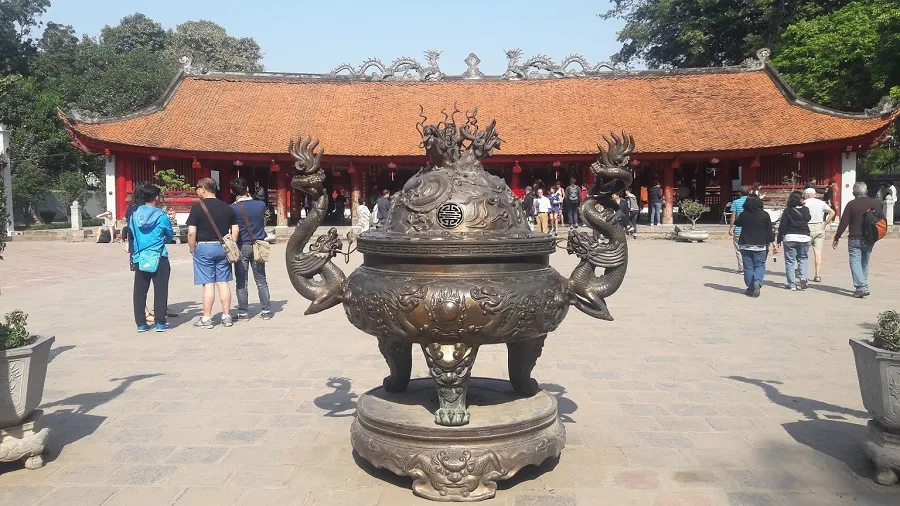
Den Khai Thanh, a compact yet meaningful architectural marvel, proudly stands north of Dai Bai Duong. Its square design, constructed from wood and stone, achieves balance and sturdiness. The red-tiled roof, detailed with sharp and refined motifs, reflects the finesse of architectural art. Den Khai Thanh is dedicated to worshiping the parents of Confucius, symbolizing filial piety and deep respect, mirroring traditional moral values in Vietnamese culture and education.
The Temple of Literature is not just a significant historical and cultural heritage site but also a captivating tourist destination, offering unique and profound experiences such as:
- Exploring the charm of ancient architecture, from the triple gates to Khue Van Cac, Dai Bai Duong, and Den Khai Thanh, where each structure is a testament to the beauty of traditional Vietnamese art.
- Enhancing understanding of Vietnamese history, culture, and education through the doctoral steles, Confucius statues, paintings, inscriptions, and valuable artifacts.
- Participating in cultural and artistic events like ca tru, cheo, quan ho performances, visiting Temple exhibitions, taking commemorative photos, and shopping for unique souvenirs.
- Engaging in intellectual and creative games, puzzles, couplets, and poetry about the Imperial Academy.
- Attending festivals, traditional holidays, and rituals for peace, fortune, and luck, to feel the sacred and solemn atmosphere, and to wish for good fortune, happiness, and success in life.
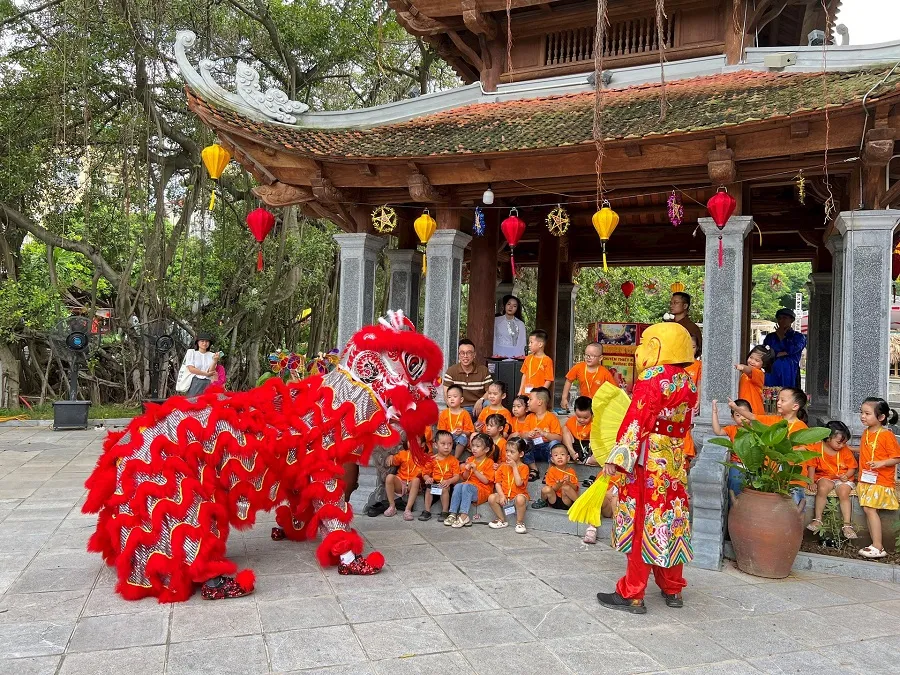
To fully enjoy your visit to the Temple of Literature, remember these tips:
- Choose optimal visiting times like early morning or late afternoon to avoid harsh sunlight and crowds.
- Wear modest, respectful clothing as a sign of respect for the site's culture and tradition. Don't forget to bring hats, umbrellas, sunscreen, and water for health protection and comfort.
- Strictly adhere to the Temple's regulations, such as no pets, no smoking, no eating or drinking, and no noise-making.
- For a deeper understanding of the Temple's history, culture, and education, consider using guided tour services or smart audio guides, and ensure you don't miss any important sites.
- Buying tickets online in advance is the best way to save time and avoid queues. Check opening and closing times to plan your visit effectively.
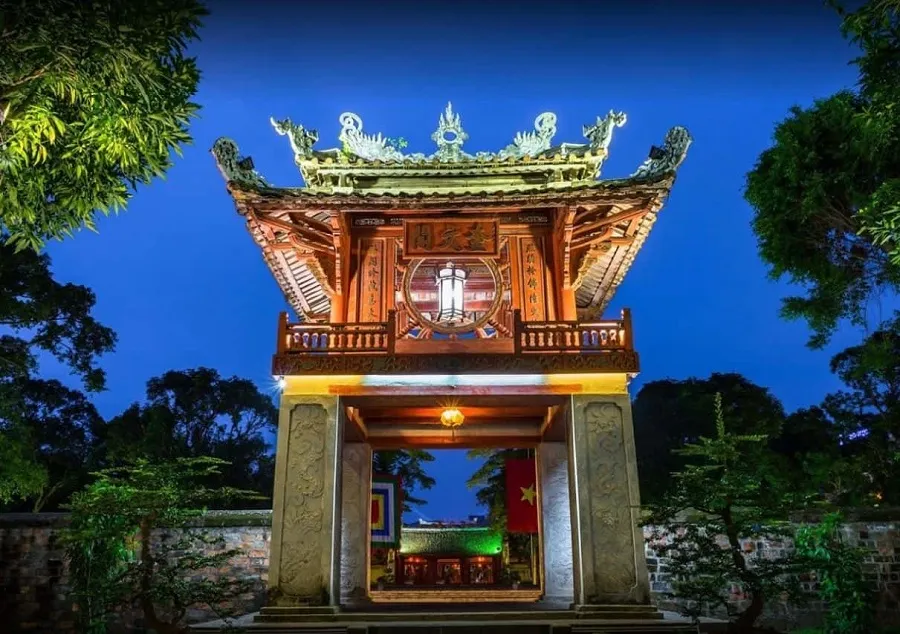
Hanoi, a thousand-year-old city, not only captivates with the Temple of Literature but also offers many other attractive sites:
- Hoan Kiem Lake: In the heart of the capital, this lake is a symbol of Hanoi's mystical beauty. Here, you can admire Ngọc Sơn Temple, Turtle Tower, The Húc Bridge, and engage in cultural activities like water puppet shows, traditional plays, chess playing, or relaxing walks or bike rides around the lake.
- Hanoi Old Quarter: A vibrant space with historical streets like Hàng Bạc, Hàng Đào, Hàng Mã, and Hàng Ngang. It's the ideal place to explore street culture, enjoy diverse culinary delights like bún chả, phở, egg coffee, and shop for unique handmade crafts and souvenirs.
- Vietnam Museum of Ethnology: A window into the diverse world of Vietnamese ethnic groups through costumes, utensils, housing, and culture. Visitors have the opportunity to experience cultural activities like traditional music performances, participate in folk games, and learn to make handicrafts.
- Ho Chi Minh Mausoleum: The resting place of President Ho Chi Minh, a site of deep historical and spiritual significance. Here, you can pay homage, learn about and honor Uncle Ho's moral example and thoughts, and visit the Stilt House, Ho Chi Minh's Flower Garden, and Ho Chi Minh Museum.
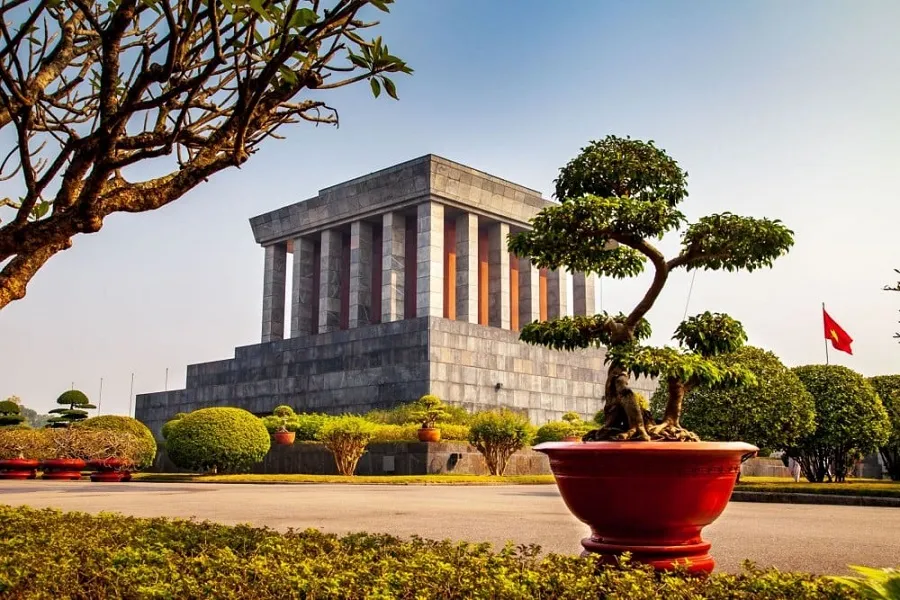
After an impressive tour of the Temple of Literature, you can find relaxation and comfort at Hanoi's top hotels:
- Hilton Hanoi Opera Hotel: A luxurious 5-star hotel located at 1 Le Thanh Tong Street, about 2 km from the Temple. The hotel stands out with its refined rooms, balconies overlooking the Hanoi Opera House. Amenities include restaurants, bars, a swimming pool, a fitness center, a spa, and a conference center.
- Sofitel Legend Metropole Hanoi Hotel: A 5-star hotel at 15 Ngo Quyen Street, about 2.5 km from the Temple. A symbol of luxury and history with its ancient French architecture. The hotel offers upscale rooms with balconies overlooking Hoàn Kiếm Lake, along with facilities like restaurants, bars, a swimming pool, a fitness room, a spa, and a conference center.
- Hanoi La Siesta Hotel & Spa: A 4-star hotel at 94 Ma May Street, about 3 km from the Temple. With a modern yet cozy design, the hotel offers rooms with balconies overlooking the Old Quarter. Facilities include a restaurant, a bar, a swimming pool, a fitness center, a spa, and a conference center.
Visit the Temple of Literature to experience its solemnity, sacredness, and beauty, to honor the predecessors who contributed to the country, and to learn valuable lessons about morality, spirit, and thought from Confucius and Vietnamese scholars. We wish you an enjoyable and enriching visit!
Some Attractive Tourist Spots in Hanoi:
Copyright © 2022 BDATrip.com | All rights reserved.